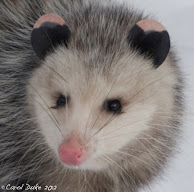Flower Hill Farm Butterflies of 2012 continues with two little Blues of the Gossamer-wings family. Last year in July, I had an exciting first capture of an Eastern Tailed-Blue Everes comyntas, which I spotted along the edge of the south field. A bit smaller than the Summer Azure, these small beauties are also considered common throughout most of the eastern half of North America.
The Eastern Tailed-Blue has three flights beginning around the middle of May through the first part of June, then the middle of July till the end of July and mid August through to late September. To make identification confusing each brood may look somewhat different. A tell tale sign of the Eastern Tailed-Blue is the orange eyespot like markings on the bottom hindwings and the tiny thread like tails, though as with the one captured here those may disappear with time. They are such beautiful little butterflies. I so wish the wings were fully open to illustrate the gorgeous blue but a peek shows a bit of the color that seems to vary between broods and sexes.
In between these flight stages would be the time to search out the single eggs and dark green caterpillars on buds and stalks of clovers (if the rabbits leave me any) and various legumes. Here at Flower Hill Farm the little blues might enjoy the vetches growing in the airy north and south fields and perhaps I might find caterpillars along the forest edge.
Eastern Tailed-Blues overwinter in their caterpillar stage.
Summer Spring Azure Celastrina ladon, is perhaps the most confusing butterfly I have ever tried to identify. Thanks to Joe from the Massachusetts Butterfly Group on Facebook, I think I have it right. The sighting of this tiny 3/4 - 1 1/4 blue was just outside our little studio last August. This makes it a summer form of the Spring Azure, if I understand correctly. The Azure is considered common and flies from early spring up to early September throughout much of the United States.
A great diversity of plants and shrubs serve as hosts for the larva that resembles a slug, including cherry, blueberries, maple, dogwood, viburnum, oak, lupine and more and more. It is a wonder since Flower Hill Farm has all of these and many more of the other listed host plants and trees that I have never seen this butterfly here before. I can only assume the birds are incredibly fastidious in searching out the caterpillars and then the butterflies, or I have just not been in the right place at the right time.
The butterflies also choose from a variety of flowers. Males congregate along streams and puddles and will sample excrement and carrion. Azures prefer fields with shrubs to an open airy field, so I now know to look more in the blueberry fields when they begin to flower, for the caterpillars prefer flowers to leaves. Right now the chrysalis forms is in hiding perhaps below the blueberry bushes in the photographs below. Azure butterflies only live for a few days, beginning courtship and then laying eggs very soon after emerging from their yellow-brown chrysalis.
Within the blueberry field above and below, Azure chrysalises may be safely awaiting the unfurling of buds.
The little caterpillars of the Eastern Tailed-Blue will have to remain hidden from the sharp eyes of the Bluebirds.
It is truly overwhelming to imagine all the hidden life within these fields . . . section of north field above and south field below . . . both will be filled with wildflowers in a months time.
The returning Tree Swallows fill the sky with fluid dance, songs and champagne like gurgles.
Their presence in the gardens and sky above is pure delight and they eat hundreds of biting insects each day.
I hope there will be plenty of food for the birds and that many of these precious blues will survive to fly about the wildflower and blueberry fields later this spring.
Our temps have dipped back down into the 30's with some sleet and snow showers promised in a day. Though I love the warmth, I would rather have these colder spring days than suddenly having summer upon us. We had a couple of days in the 70's this past week and the heat makes all the new emerging life move too quickly. I so love a slow spring after a long winter, one that allows us to pause and celebrate renewal . . . and now I have a bit more time to catch up with last years butterflies!





































































































































